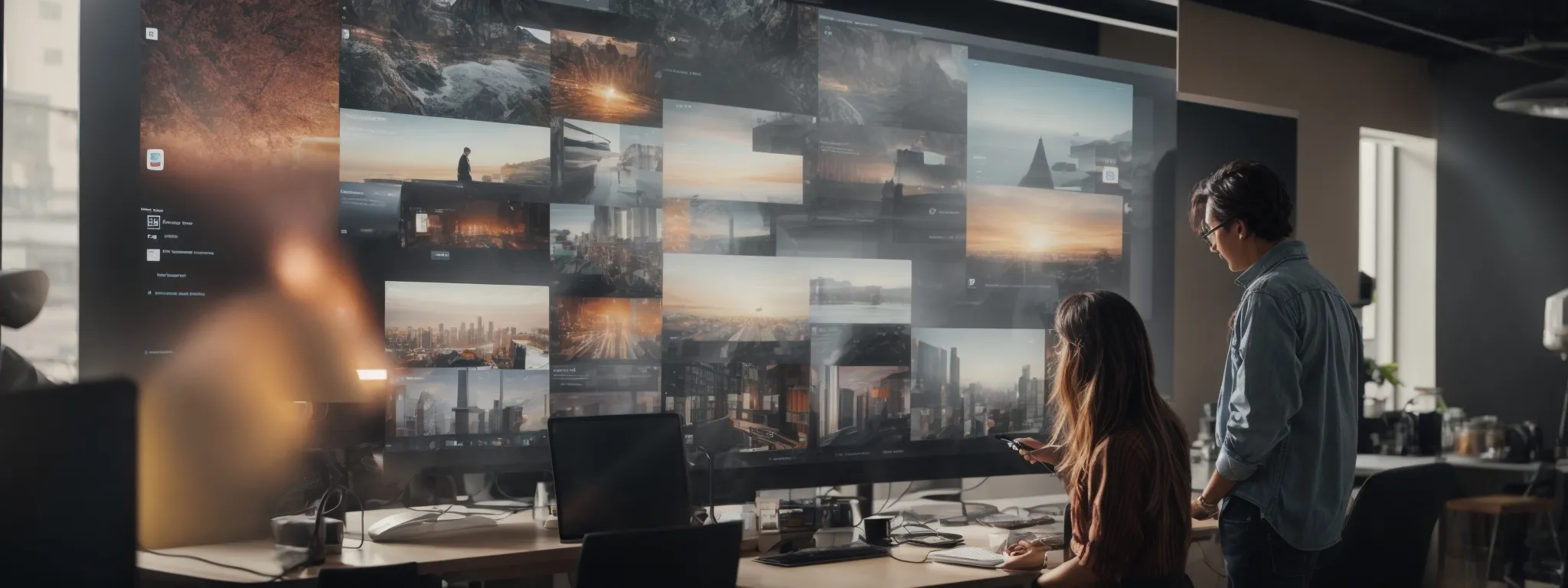Creatives’ Success: SEO for Designers
Maximizing Visibility: SEO Strategies for Designers to Achieve Success In a digital realm where visibility equates to opportunity, search engine optimization serves as the pivotal cornerstone for […]
Maximizing Visibility: SEO Strategies for Designers to Achieve Success
In a digital realm where visibility equates to opportunity, search engine optimization serves as the pivotal cornerstone for designers aspiring to showcase their work.
From interior design mavens to graphic illustration virtuosos, the mastery of SEO strategies is essential for any creative looking to elevate their online presence.
Whether it’s a well-composed portfolio website catching the eye of a potential client or an artist’s work ascending Google search results, SEO lays the groundwork for these achievements.
LinkGraph’s SEO services present a roadmap for designers to navigate the complexities of online discoverability with finesse.
Keep reading to unveil how an adept approach to SEO can transform your design portfolio into an audience magnet.
Key Takeaways
- SEO Is Crucial for Designers to Increase Visibility and Ensure Their Portfolios Reach Their Target Audience
- Thoughtful Integration of SEO Content Strategy and Keyword Optimization Enhances a Designer’s Online Presence and Search Rankings
- Regular Content Updates and Blog Posts With Strategic Keyword Usage Can Improve a Designer’s SEO Success
- A User-Centric Design That Prioritizes Mobile-Friendliness, Intuitive Navigation, and Accessibility Is Key for High Search Engine Rankings
- Social Media Engagement and Backlink Generation Through Guest Blogging and Industry Collaboration Are Significant for Strengthening a Designer’s SEO Strategy
Understanding SEO: A Designer’s Guide to Getting Noticed

For designers, the realm of search engine optimization (SEO) presents an array of opportunities to amplify their visibility and showcase their work to a broader audience.
The journey begins with grasping the basics of SEO, understanding its pivotal role in a connected digital landscape, and recognizing how thoughtful optimization can set a portfolio website apart in the bustling realm of Google search results.
Creators must tailor their online portfolios meticulously, leveraging SEO to ensure their designs not merely linger in the shadows but command the attention they deserve.
This encompasses not only the aesthetic components but the very spine of web presence – metadata.
By carefully curating this data, designers enhance their online footprint, priming their digital galleries for discovery and engagement.
Embracing these strategies, creatives unlock the potential for their portfolios to resonate with visitors, maximize exposure, and translate virtual footfall into tangible opportunities.
Grasping the Basics of SEO and Its Importance
In the pursuit of professional success, designers face the undeniable imperative of mastering SEO. Embarking on SEO education equips artists with the ability to align their online portfolio with the algorithms of search engines, bolstering their visibility and ensuring their work is accessible to a targeted audience.
At the core of SEO’s importance lies its power to transform a portfolio site from an isolated digital space into a beacon for potential clients and collaborators. Designers become architects of their own discoverability, constructing a web presence that competently navigates the currents of Google search results and captures the attention of those who matter most in their field.
Tailoring Your Design Portfolio for Search Engines
For designers intent on navigating the intricate terrain of search engine optimization, the first step involves the judicious application of SEO content strategy to their portfolio websites. Designers who integrate this strategy seamlessly within their pages catalyze the allure of their site, constructively influencing how search engines interpret and rank their content in relation to user queries.
Central to enhancing a design portfolio’s search engine friendliness is the adept inclusion of targeted keywords that resonate with a designer’s brand, style, and niche. Doing so requires not only an in-depth understanding of the market but also a commitment to leveraging tools like LinkGraph’s SearchAtlas SEO software, which can provide invaluable insights to shape a potent SEO strategy tailored for creatives eager to excel online.
Harnessing Metadata to Enhance Online Presence
Articulating a compelling narrative through metadata underpins a robust online presence for designers. With tactically crafted tags and descriptions, an individual’s body of work becomes markedly more discoverable, inviting search engines to index pages in a way that aligns with the queries of prospective clients or enthusiasts. LinkGraph’s SEO services provide expertise in elevating this aspect of website design, ensuring that metadata works tirelessly behind the scenes.
Optimizing a portfolio site with well-researched metadata further reifies a designer’s brand, embedding a unique digital identity within the fabric of the web. Through the meticulous application of SearchAtlas SEO software, sophisticated metadata practices forge a bridge between a designer’s distinctive style and the search habits of their desired audience. This bridge serves as a critical pathway by which visibility is amplified and professional connections are solidified.
Crafting High-Quality Content With Design in Mind

As designers carve out their distinctive niche online, the integration of SEO strategies into their content becomes quintessential for achieving prominence.
Mastering the art of identifying targeted keywords facilitates a resonance with their brand, beckoning the attention of search engines and, consecutively, the right clientele.
Regular updates to content not only showcase a commitment to fresh, innovative works but also serve the dual purpose of keeping SEO rankings robust.
Furthermore, the construction of blog posts that marry visual allure with SEO acumen invites a deeper engagement from visitors, ensuring that a designer’s online presence is as captivating as it is discoverable.
Embarking on this holistic approach to content development is imperative for designers seeking to navigate the competitive digital sphere effectively.
Identifying and Utilizing Keywords in Your Design Niche
Effective keyword identification is the cornerstone of a design-related SEO strategy. When a designer harnesses the right keywords, they ensure their portfolio website resonates clearly with the search patterns of their target audience, making each artistic showcase or case study a beacon for business growth. LinkGraph’s SEO services employ a nuanced approach, incorporating thorough research and strategic keyword placement to bridge the gap between designers’ offerings and their potential clients’ searches.
Once identified, the integration of these keywords into an online portfolio becomes a deliberate, skillful endeavor. The expertise offered by LinkGraph’s White Label SEO services allows designers to cleverly weave keywords into their web content, from gripping blog posts to compelling case descriptions, without sacrificing the integrity of their creative vision. This seamless fusion of SEO and design ensures that digital portfolios do not simply exist online but thrive within the competitive terrain of Google search results.
Benefits of Regular Content Updates for SEO
Regular content updates signal to search engines that a designer’s website is a living, dynamic entity, constantly evolving with new work and insights within their field. This consistent refreshment encourages the search algorithm to revisit and re-evaluate the site, often resulting in improved rankings and, in turn, increased visibility to the desired audience.
A designer maintaining an up-to-date portfolio with insightful blog posts or project case studies provides recurrent opportunities to integrate relevant keywords, thereby improving search result relevance. LinkGraph’s SEO services specialize in guiding these updates, ensuring that content remains both fresh and strategically optimized for search engine success.
Creating Visually Appealing and SEO-friendly Blog Posts
Creating blog posts that blend visual aesthetics with SEO may seem daunting, but it’s a critical component of a comprehensive online strategy for designers. By implementing a thoughtful SEO content strategy that includes guest posting services and LinkGraph’s blog writing services, designers ensure their blogs do more than catch the eye; they also capture rankings in search engine results.
These visually-rich blog posts must integrate tactical keyword usage without detracting from the overall message or design. An intuitive blend of graphic design elements and SEO-driven text use not only conveys the creator’s style but also adheres to search engine guidelines, resulting in content that thrives in both visual appeal and searchability:
| Element | Impact on SEO | Impact on Design |
|---|---|---|
| Keyword-Rich Titles | Improves visibility and relevance in search results. | Attracts visitor interest and sets the tone for the content. |
| Engaging Visuals | Encourages longer site engagement, a positive metric for SEO. | Reflects the designer’s style and enhances message delivery. |
| Strategic Meta Descriptions | Drives click-through rates from search listings. | Provides a succinct preview that aligns with the visual story. |
The Role of User Experience in SEO for Designers

In today’s digital ecosystem, an exemplary user experience (UX) is not merely a supplementary aspect for designers; it sits at the heart of successful SEO outcomes.
A user-centric approach to online portfolio design is paramount, as it directly influences search rankings.
Proactively optimizing a website for mobile responsiveness, intuitive navigation, and accessibility principles is not just best practice—it’s essential for sustaining traction in the digital space.
For designers, a synthesis of these UX elements with robust SEO strategies propels websites beyond mere visual engagement, fostering meaningful interactions and aiding in the achievement of higher search rankings.
As such, a thoughtfully crafted UX becomes integral to the architecture of a site optimized for both performance and presentation.
Ensuring a Mobile-Friendly Design for Better Rankings
Designers prioritize mobile-friendliness, acknowledging its significant role in bettering search engine rankings. LinkGraph’s SEO services provide the expertise necessary to ensure portfolio websites are optimized for mobile devices, providing a seamless experience for visitors and a favorable evaluation from search algorithms.
Mobile optimization stands as a critical factor in achieving higher visibility in search results, where quick loading times and responsive design are imperative. Such meticulous attention to mobile UX by LinkGraph’s team aligns with current SEO best practices, elevating a site’s stature amidst the competitive digital landscape of design professionals.
Improving Site Navigation to Reduce Bounce Rates
Navigating the intricacies of site design, professionals must address user navigation as a pivotal component of SEO: a convoluted journey through a website precipitates higher bounce rates, which in turn can signal to search engines a lack of relevance or user engagement. It is within the purview of LinkGraph’s SEO services to streamline navigation, crafting a user experience that not only captivates but also guides visitors effortlessly through a designer’s online showcase.
- Assessment of the current navigation structure to identify potential user pain points.
- Implementation of intuitive, clearly labeled menus that align with user expectations.
- Strategic placement of calls to action to lead visitors naturally to key areas of interest.
- Regular reviews and updates to ensure navigation evolves with the portfolio’s content and audience preferences.
Reducing bounce rates hinges on providing a coherent roadmap for site visitors: from the moment they arrive on a portfolio page to the final desired action, whether that’s a contact request, portfolio download, or service inquiry. LinkGraph’s expertise in SEO ensures that by refining the navigation pathways, a designer’s website is primed not only to captivate but to retain visitor interest and thereby enhance overall traffic quality and search engine ranking.
Using Design Principles to Enhance Website Accessibility
Applying design principles to enhance website accessibility is more than a benevolent practice; it shapes a cornerstone of SEO success for designers. Integrating accessibility features enhances the user experience for a diverse audience, adhering to ethical standards and boosting SEO performance by making content more approachable and navigable for all users, including those with disabilities.
An accessible website reflects the inclusivity of a designer’s brand and may contribute to favorable search engine rankings. Strategies like ensuring proper contrast ratios, providing text alternatives for non-text content, and designing for keyboard navigation not only benefit users with impairments but also amplify the site’s reach by adhering to universal design principles:
| Accessibility Feature | SEO Benefit | User Experience Enhancement |
|---|---|---|
| Alt Text for Images | Improves understanding for search engines and supports image searches. | Provides context for users who rely on screen readers. |
| Descriptive Link Text | Enhances the relevance of anchor text for SEO, offering clearer insights into linked content. | Makes navigation more intuitive for all users, aiding in the understanding of link destinations. |
| Keyboard-Friendly Design | Search engines favor sites that accommodate diverse browsing methods. | Allows users to navigate without a mouse, essential for those depending on assistive technologies. |
Each element within an accessible website design weaves into a broader canvas that search engines evaluate for user friendliness, thus influencing SEO. By addressing accessibility through design, a designer reveals commitment to wide-ranging audience engagement and establishes a foundation for enhanced search engine considerations.
Leveraging Social Media to Boost Your SEO Efforts

In the rapidly evolving digital landscape, social media emerges as a powerful catalyst for enhancing the SEO endeavors of designers.
As the intersection between social engagement and search engine optimization becomes increasingly evident, designers must judiciously select the most appropriate platforms to exhibit their work, thereby maximizing exposure and reinforcing their brand presence.
The subsequent promotion of content and interaction with an audience paves the way for measurable SEO benefits.
By understanding and tracking the influence of social signals on SEO rankings, designers can adeptly navigate the social sphere to complement their SEO strategy, further solidifying their status in the competitive realm of design.
Choosing the Right Platforms to Showcase Your Design Work
Selecting the most appropriate social media platforms is a strategic step designers must take to expand their digital footprint and enhance their SEO metrics. Each platform’s unique user demographic and content style caters to different facets of a designer’s portfolio, whether the intent is to highlight visual artistry on Instagram or professional connections on LinkedIn.
By aligning their social media presence with their branding goals, designers amplify the reach of their content. This astute allocation of resources to platforms where their target audience is most active not only increases engagement but also creates backlinks, enhancing overall SEO performance and driving traffic to the designer’s main website.
Strategies for Promoting Content and Engaging With Your Audience
Designers must recognize that engagement on social media is not a passive activity; it requires proactive and intentional strategies to echo a designer’s brand and pique audience interest. Employing targeted campaigns, interactive stories, and limited-time promotions captivates followers by providing a sense of involvement and exclusivity, which can galvanize online interactions that contribute positively to SEO metrics.
Another impactful strategy entails the collaboration with influencers and like-minded creatives to share and promote content. This partnership creates a synergy that extends the content’s reach, drives meaningful engagement, and establishes a network of authoritative backlinks—all instrumental in bolstering the SEO performance of a designer’s online portfolio.
Tracking Social Signals and Their Impact on Your SEO Rankings
Designers navigating the digital landscape understand that social signals from platforms like Instagram, Pinterest, or LinkedIn can have a non-direct impact on SEO rankings. These social cues, which include shares, likes, and comments, serve as testimonies to content relevance and quality, influencing search engine’s consideration of a site’s popularity and user engagement. Consequently, designers need to track and analyze these signals to fine-tune their social Strategies for Heightened SEO Effectiveness.
One critical step in leveraging these social signals is establishing a measurement plan to discern their impact on web traffic and search rankings:
- Tracking referral traffic from social media to the designer’s main website.
- Analyzing the correlation between social engagement levels and changes in SEO rankings.
- Monitoring brand mentions across social platforms to evaluate brand reach and authority.
By implementing a comprehensive analytics approach, designers gain the insights needed to align their social media endeavors with broader SEO objectives, ensuring that both disciplines work in tandem to maximize online visibility and drive success.
Building a Network of Backlinks for Designers

For designers seeking to forge a dominant presence within the competitive digital arena, the strategic accumulation of backlinks is a critical facet of a comprehensive SEO strategy.
These links serve as endorsements, signalling to search engines that a designer’s work stands not alone but within a network of recognized authority.
By engaging in guest blogging, collaborating with key influencers and industry professionals, and leveraging the prestige of design awards and competitions, designers can obtain high-quality, relevant backlinks that bolster the credibility of their sites.
This approach is not only a testimony to their prowess but also a powerful contributor to their SEO growth, enhancing visibility across the vast expanse of the internet.
Guest Blogging to Get Your Work Featured on Other Sites
Guest blogging stands as a pivotal technique for designers seeking to elevate their online presence and authority. By contributing their expertise and creative insights to reputable platforms, designers not only gain exposure but also establish valuable backlinks to their portfolio sites, a critical boon for SEO enhancement.
Through LinkGraph’s guest posting services, designers can strategically place their work on high-traffic sites within their niche, effectively casting a wider net for potential clients and collaborators while simultaneously reinforcing their search engine standing with quality external links.
Collaborating With Influencers and Industry Professionals
Designers who align with influencers and professionals in their industry can forge powerful connections that bolster their SEO standing. Such collaborations often result in the sharing of content across various platforms, which can lead to enhanced exposure and the creation of authoritative backlinks to the designer’s portfolio site.
Networking with established figures opens doors to new audiences and can lead to mentions in blogs, features in digital galleries, or even joint ventures. Each nod from an influencer or industry leader acts as a beacon to search engines, affirming the credibility and relevance of a designer’s online presence.
Using Design Awards and Competitions to Gain Credible Links
Participation in design awards and competitions offers more than just the thrill of recognition; it provides a strategic avenue for designers to acquire credible backlinks. Winning or even being shortlisted in these competitions often leads to features on authoritative websites, which in turn boosts the designer’s SEO through high-quality links from trusted sources in the industry.
Designers should meticulously select competitions that align with their brand and portfolio offerings to ensure relevance and authority in the backlinks they acquire. The process includes:
- Identifying prestigious awards within the designer’s specialty.
- Submitting their most compelling work for consideration.
- Leveraging any accolades received for promotional efforts.
By integrating awards and accolades into their marketing and SEO strategies, designers reinforce their reputation while enhancing their visibility in the eyes of both their target audience and search engines alike.
Measuring Success: SEO Tools and Analytics for Designers

The digital stage demands that designers not only curate aesthetically pleasing content but also sustain a data-driven approach to their online presence.
Within the scope of SEO, utilizing cutting-edge tools and analytics is now an integral segment of strategy development for creatives.
The essence of this analytical approach lies in its ability to furnish actionable insights, driving designers to refine their strategies and tailor their portfolios for optimal online performance.
Subsequent discussions will uncover essential SEO tracking tools, shed light on the nuanced process of interpreting data, and reveal adjustments that may surge a designer’s portfolio to the forefront of their industry.
Introduction to Essential SEO Tracking Tools
For designers committed to ensuring their portfolio’s prominence in a saturated market, embracing the advancements in SEO tracking tools is indispensable. LinkGraph’s SearchAtlas SEO software embodies the innovative solutions that cater to the nuances of design portfolios, providing detailed analytics that allow artists to gauge the efficacy of their SEO strategies.
These essential tools afford designers with the necessary metrics to understand visitor behaviors, track ranking progress, and fine-tune their online presence for maximum impact. Exemplary tools like LinkGraph’s suite facilitate informed decision-making, propelling creative works to the upper echelons of search engine results:
- Real-time keyword tracking to adapt swiftly to changes in search trends.
- Comprehensive backlink analysis to evaluate the strength of external connections.
- Detailed traffic reports to identify which designs captivate the audience most.
Interpreting Data to Refine Your SEO Strategy
Interpreting data is a transformative process that enables designers to identify patterns, understand audience preferences, and adjust their SEO tactics for improved outcomes. With insights drawn from SearchAtlas SEO software’s granular analytics, designers can pinpoint which elements of their portfolio captivate viewers, then replicate these successes across their website to heighten overall engagement and search rankings.
LinkGraph’s SEO services facilitate a tailored approach by aiding designers in deciphering complex datasets, such as bounce rates and user dwell time, transforming them into strategic decisions that sharpen the focus of the SEO campaign. Such data interpretation is pivotal for designers to refine their online presence, ensuring their artistic offerings are not just seen but resonate with their intended audience in meaningful ways.
Adjusting Your Design Portfolio Based on Analytical Insights
Armed with analytical insights, designers are empowered to make calculated adjustments to their online portfolios, ensuring every element aligns with the evolving trends and preferences illuminated by user data. This adaptive approach facilitates an ever-relevant and compelling digital presence that captivates both existing and potential clientele.
Aligning portfolio elements with user data results in a tailored experience that encourages deeper engagement and, by extension, more substantial SEO success. Designers can capitalize on the data trends by emphasizing the most popular works or reconfiguring the site layout to better serve user preferences:
| Analytics Metric | Insight Gained | Actionable Adjustments |
|---|---|---|
| Pageviews | Indicates the most visited pages. | Highlight popular projects and refine weaker sections. |
| Average Session Duration | Reflects user engagement levels. | Enhance interactive elements to prolong visits. |
| Bounce Rate | Reveals initial user interest or lack thereof. | Optimize landing page design to capture attention. |
Conclusion
In summary, maximizing visibility through SEO is vital for designers aiming to succeed in the highly competitive digital space.
By mastering SEO principles and strategically implementing them, designers enhance their online portfolios, ensuring that their work not only stands out but also reaches their target audience.
Fundamental to this process are the meticulous crafting of metadata and the use of targeted keywords that propel their work to the top of search engine results.
Regular content updates and the integration of visually appealing, SEO-friendly blog posts further solidify a designer’s web presence.
Additionally, a top-tier user experience is crucial, with mobile optimization and accessible design playing key roles in elevating search rankings and user satisfaction.
Social media strategies and the creation of a network of credible backlinks serve to amplify a designer’s reach and authority, while the use of advanced SEO tools and analytics provides the insights necessary for continual refinement and adjustment of their online portfolio.
Ultimately, the deliberate application of SEO strategies enables designers to harness their full potential, turning their digital footprint into a magnet for opportunities and professional growth.














































































